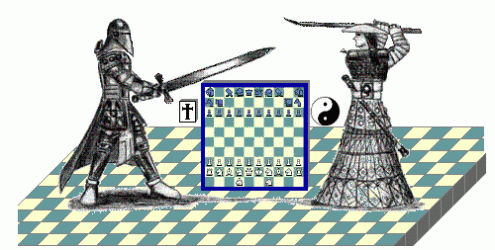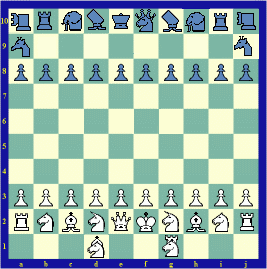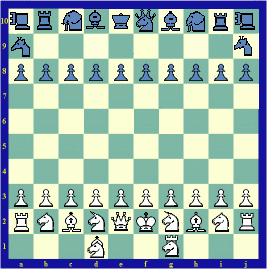CCC - The Clash of Civilizations Chess
"...the principal conflicts of global politics will occur between nations and groups of different civilizations. The clash of civilizations will dominate global politics". Samuel P. Huntington.The Clash of Civilizations - "Chess is War..War is Chess.."*

The idea of this variant of the game in itself is not new. The ancestor of this variant undoubtedly is "War of the World" written by Jean-Louis Cazaux and "Chess with Different Armies" by Betza. But after reading S.Huntington`s article "The Clash of Civilizations" I decided that better to solve a complicated questions not on a battle - field, but behind a Chess board. Of course, it is a dream, but it is a good dream. Behind a board there are two Chess Armies made from the most popular pieces using in Western and Eastern Chess games.
Pieces for Western Army (W.A.) are taken from the most popular Chess games: Ordhodox Chess (Pawns, Bishops, Rooks, Knights, Queen), Capablanca Chess (Archbishop and Chancellor) and Unicorn Chess (Unicorns).
Pieces for Eastern Army (E.A.) are taken from the most popular Eastern Chess games: Tamerlane Chess (Fils, Giraffes, King), Maharaja and the Sepoys (Maharaja), Shogi (Rooks and Bishops), Xiangqi (Pawns and Cannons).
It is an abstract and asymmetric (as opponents have different kinds of the weapons (pieces)) wargame with no random chance.
Setup
Board 10x10.E. A. - (Black side and vice - versa), from a10 to j10: First row - Cannon, Rook, Fil, Bishop, King, Maharaja, Bishop, Fil, Rook, Cannon; Second row: from a9 to j9 - Giraffe (a9) and (j9); Third row: from a8 to j8 - Pawns.
W. A. - (White side and vice - versa), from a1 to j1: First row - Archbishop(d1), Chancellor(g1); Second row - Rook, Knight, Bishop, Unicorn, Queen, King, Unicorn, Bishop, Knight, Rook; Third row - Pawns.
For E.A. Pawns protection from a10 to j10 is - 2 2 1 1 3 3 1 2 2 2. The total protection of Pawns is 19.
For W.A. Pawns protection from a1 to j1 is - 1 2 1 3 4 4 3 1 2 1. The total protections of Pawns is 22. White King has to be located on a dark square and vice - versa. As is known a King is the most important piece of Chess game. Considering special propensity of ancient people to the well-known number 0.618 (golden section)* , it is clear why a King is always located on one square in the right from the middle of a board. As 0.6/1 (width of a board) = 0.6. Obviously this number approximately is equal to the 0.618. For this reason the Kings are located not symmetrically in a Orthodox Chess.
Pieces
W. A. of pieces - P, R, B, N, A, C, Q and K - wellknown pieces. The Unicorn (or Nightrider) moves like a chess Knight, but may continue a series of leaps in the same direction. One of the most popular fairy chess pieces, it was invented in 1925 by T. R. Dawson. The Chancellor (C) - has the combined moves of a Rook and a Knight. The Archbishop (A) - has the combined moves of a Bishop and a Knight.E. A. of pieces - The Cannon (Ca) moves differently when it moves to capture than when it moves passively. Ca - moves passively as an Orthodox Rook. Ca - moves to capture as an Orthodox Rook which is required to hop over a single screen. In other words, Ca - capture by hoping over a second piece in order to capture a third piece. For example, Ca - on a1 can take a piece on f1 when exactly one of the points b1, c1, d1, or e1 is occupied by a piece of either color. Ca - only capture when hoping and only hop when capturing. They may never hop over more than one piece in a given move. Ca needs an intermediate piece between itself and its victim. The Cannon jumps the intermediate and take the victim on its square. The intermediate is left unaffected. The Bishop (B) and the Rook (R) moves as an Orthodox Rook and Bishop.The Fil (F) moves like King or jumps two squares diagonally and straight (horizontally or vertically). It is not obstructed by a piece on the jumped square (may jump the intervening square). It is a combined piece from three pieces of Tamerlane Chess - an Elephant, a King and a War Engine. The Giraffe (G) moves one diagonal and then after that at least three or more straight. For instance, when on a1 the Giraffe can move to b5, b6, b7, b8, b9, b10 or f2, g2, h2 an so on. It is obstructed by a piece on the jumped square. For both sides the Pawns and the Kings are same and moves of an Orthodox Pawns and King. The Maharaja (M) is most powerful piece, moves of an Orthodox Queen and an Orthodox Knight and capable of giving mate by itself. In general there are 13 various pieces with different moves.
Rules
The game follows the Standart Orthodox Chess rules with two exceptions. 1. Castling is impossible. 2. Pawns can be promoted only to pieces from their own army. In Figure 1 is shown general view of CCChess,Figure 1, Episode 1, W.A. = E.A.
Notes
Understanding the relative strength of one`s resources is a key generic element of strategy. Both of the contenders have equal quantity of pieces, equal forces and different armies but they are not located equally or symmetrical. It once again emphasizes their distinction from each other. A density of distribution of power lines (d.d.p.l.) for both armies defined as the total distribution of power lines (t.d.p.l.) of pieces (where are pieces located on the center of a board e5,e6,f5 and f6) to total quantity of squares of the Chess board - 100. Therefore at the start of the game each side has equal of a "latent strength ", (for example, a "latent strength" for Orthodox Chess is equaled to 1,52). For the best strategic and tactical planning of a game it is possible to take advantage of following power dependences between pieces:M = Q + N > Q = R + B > C = R + N > A = B + N > R = F > Ca > B = U > G > N ; and approximately M = (12P - 14P) or W.A. = E.A.
Sometimes a "length of a jump" is in the "inverse proportion to strength" of a jumping piece, f.exp. N > J. For strengthening a game for the East Army, Jeremy Good has offered idea of replacement the Cannon on the Leo (L). The Leo moves like a Queen when it does not take, i.e., any number of empty squares on an orthogonal or diagonal line. When the Leo makes a capturing move, it moves along an orthogonal or diagonal line, but it must jump over exactly one piece, regardless its color: when taking, the Leo also moves over a horizontal, vertical or diagonal line, jumps over the first piece it meets (which may either be friendly or from the opponent) and then continues over the line until the next piece it sees: if that is from the opponent, the Leo can take it by moving to that position. In Figure 2 has shown CCChess with the Leo. In this variant of game the Leo is most dangerous piece.
Figure 2, Episode 2, W.A. < E.A.

It is obvious, that L > R, and naturally that E.A. with the Cannons more weaker than with a Leo.
L R F B K M B F R L / G(a9) . . . . . . . .G(j9) / p p p p p p p p p p
Pawns protection: 2 2 1 1 3 3 1 2 2 2
In Figure 3 is shown CCChess with the Monk (O) (It is looks like the Fao from Dervish Chess by Benoit Dauphin). The monk is meant a name of the Buddhist cleric. The Monk is the diagonal counterpart of the Cannon. The Monk moves passively as an orthodox Bishop. The Monk moves to capture as an orthodox Bishop which is required to hop over a single screen. Between the Bishop, the Leo, the Cannon, and the Monk there is a following dependence: Leo = Cannon + Monk;
In this variant of a game the Bishop was replaced with the Monk.
Ca R F O K M O F R Ca / G(a9) . . . . . . . . G(j9)) / p p p p p p p p p p
Pawns protection: 2 1 1 1 2 2 1 2 1 2
Figure 3, Episode 3, W.A. > E.A.

And at last, Episode 4 with the Leo, the Monk and the Cannon together, Figure 4
Figure 4, Episode 4, Super W.A. = Great E.A.

L . O F K M F O . L / G (a9) Ca(b9) . . . . . . Ca(i9) G(j9) / p p p p p p p p p p
Pawns protection for this basic variant from a8 is: 2 1 1 2 2 2 2 2 1 2
Four variants of an arrangement of the E.A. enable to test the W.A. for durability, for different variants of collision:
Episode 1 - W.A. = E.A. ; Episode 2 - W.A. < E.A. ; Episode 3 - W.A. > E.A. ; Episode 4 - Super W.A. = Great E.A.
Episode 5 - Super W.A. versus Tamerlane and Great Turkish Chess (variant II, John Gollon) (G.T.T.C.). Setup :
R N O M K P Q O N R / p p p p Ps Ps p p p p / . . . . F F . . . .
Two special pawns (Ps - e9,f9) moves only one square straight forward or diagonally forward. The Joker (J - f10) moves one square in any direction, like a King. All above mentioned pieces wellknown pieces. Setup for Great Turkish Chess was a little changed. The game follows the Standart Chess rules with one exception. King's Succession Rule ( Tamerlane or Jean-Louis Cazauxs rule): a King in checkmate is lost but this does not constitute the end of the game if its player still has one Joker and that this man is not itself in check. In such a case, King and Joker exchange their positions. This counts as one turn. The checking player is free to take or not the Joker.This process can be repeated as long as the above conditions are fulfilled. They are a second and a third chance as in Tamerlane's chess. Pawns may be promoted to a Joker, too. Super W.A., Setup:
PPPPPPPPPP / RNBAQKABNR / ..CaC..CCa..
Pawns protection: 1223553221
Figure 5, Episode 5 - Super W.A. vs Great T. T. C.

Ps = 1.5-2p; U > J
The given game will be interesting to fans of a chess games and will enable to test behind a chessboard various types of strategy, tactical methods and stratagems not conterminous with each other. It would be desirable to finish with following words:
"For the relevant future, there will be no universal civilization, but instead a world of different civilizations, each of which will have to learn to coexist with the others". Samuel P. Huntington.

The End of War
A P P E N D I X
Below, graphic representations of used pieces are shown:
 - Maharaja;
- Maharaja;  - Queen;
- Queen; - King;
- King; - King (E.A. or T.T.C.);
- King (E.A. or T.T.C.);  - Bishop;
- Bishop;  -
Giraffe;
-
Giraffe;  - Fil;
- Fil;  -
Cannon;
-
Cannon; -
Monk;
-
Monk;  - Leo;
- Leo;  - Knight;
- Knight;  - Unicorn;
- Unicorn;  - Chancellor;
- Chancellor;  -
Archbishop;
-
Archbishop;  -
Rook;
-
Rook;  - Pawn;
- Pawn;  - Special Pawn;
- Special Pawn; -Joker.
* - art by Marc Dahl.
* - The Golden Section (The Divine Proportion) is a line segment divided into two parts. Point C (location of the King in a Chess) is positioned such that the ratio of the short half to the long half is equal to the ratio of the long half to the whole. Symbolically:
A------C---B where CB / AB = AC / AB, or AB^2 = BC x AC
 This 'user submitted' page is a collaboration between the posting user and the Chess Variant Pages. Registered contributors to the Chess Variant Pages have the ability to post their own works, subject to review and editing by the Chess Variant Pages Editorial Staff.
This 'user submitted' page is a collaboration between the posting user and the Chess Variant Pages. Registered contributors to the Chess Variant Pages have the ability to post their own works, subject to review and editing by the Chess Variant Pages Editorial Staff.
By Namik Zade.
Web page created: 2006-03-31. Web page last updated: 2006-03-31

